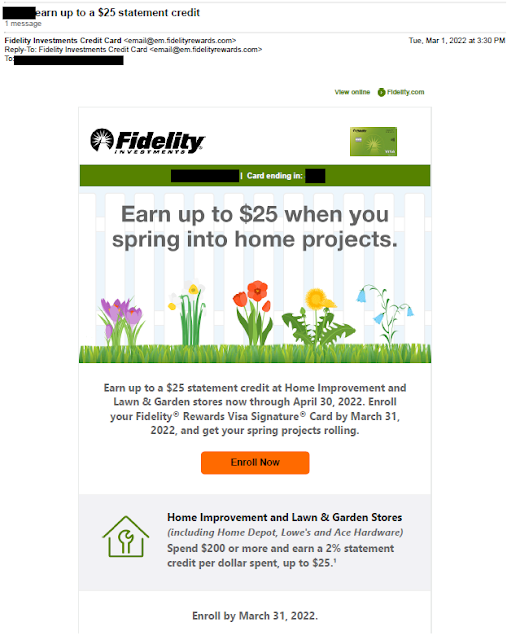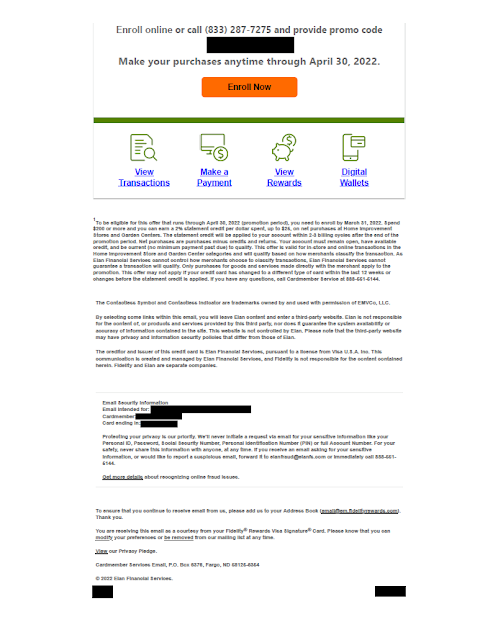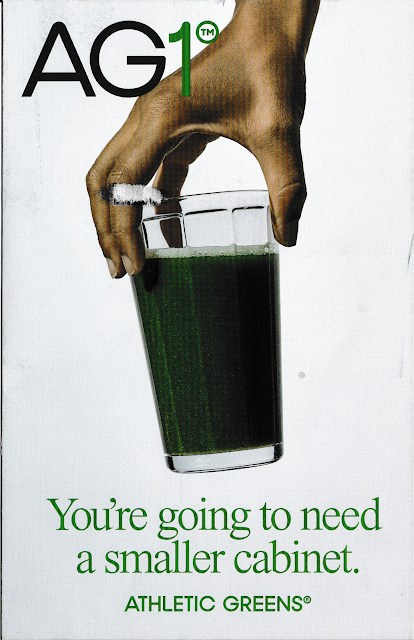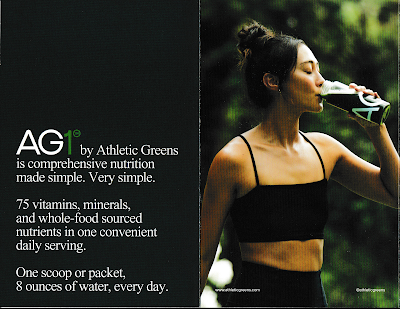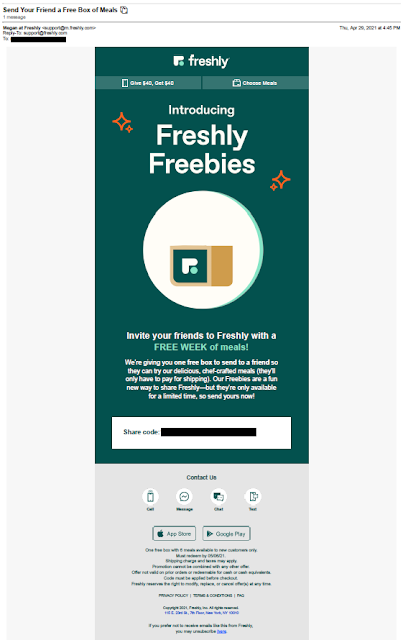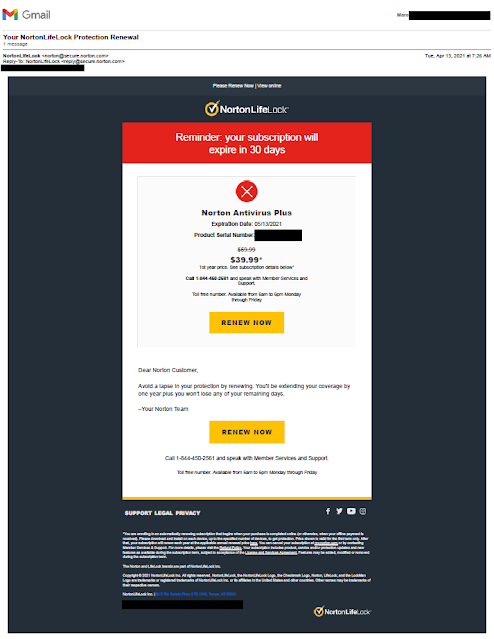- Your offer should be simple to explain and allow customers to easily benefit.
- Don't forget to reinforce your basic product benefits.
Examples of and lessons from communications that neglect basic direct marketing Best Practices.
4/04/2022
Fidelity Rewards Visa: Offering Nothing for Something, or simply unclear?
3/06/2022
BCHP: A hard-to-find doctor for my non-existent child
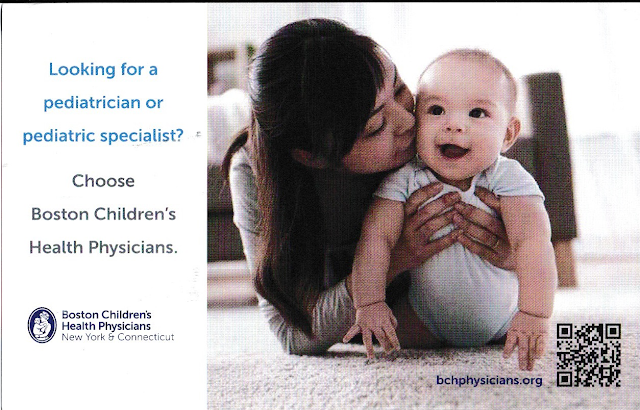 |
| Mommy is happy with her healthy baby. |
The front of the postcard simply suggests that I choose Bost Children's Health Physicians. It doesn't suggest why I choose one of their doctors. What makes their physicians desirable? To put it in marketing terms, what is BCHP's unique selling proposition?
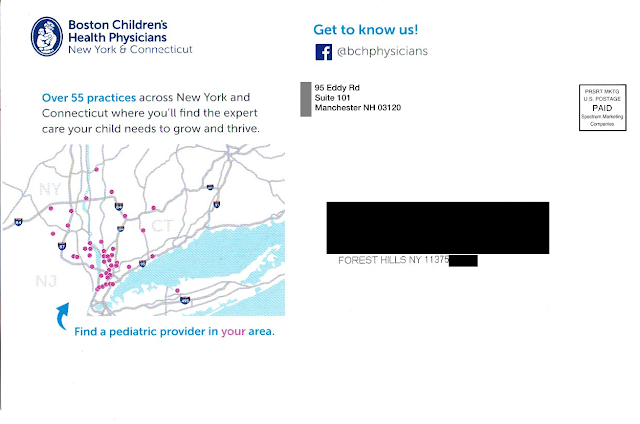 |
| Where is Forest Hills, Queens? Not in the area shown on the postcard. |
Buried on the bottom right corner of the picture of mom and her smiling baby is a URL leading to the Boston Children’s Health Physicians home page. Somewhere on that home page is information that supports the postcard’s messaging, but it isn’t easy to find. The QR code doesn’t lead to the same page as the URL; it leads directly to the practice locator page. And the placement of the QR code (within an image on the opposite side) is a Fail for Creative.
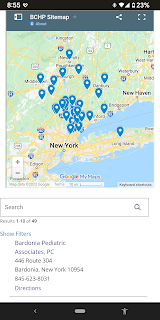 |
| BCHP locations not quite near Queens |
As the crow flies, the distance from Forest Hills, Queens, NY to Bardonia is about 27 miles. As the parent drives in traffic, however, it is two toll bridges and typically an hour drive or longer with a sick or tired child in the back seat. (That assumes the parent has a car. After all, this is New York City.) This long distance to a physician confirms that the postcard was poorly targeted geographically – another Fail for Targeting.
Returning to the caption below the map, what is a “pediatric provider?” Why use that kind of industry jargon when the front of the postcard uses “pediatrician” and “pediatric specialist” while the address side of the postcard cites having 55 “practices”? Why throw yet another term out there? I realize I’m not a parent but, if I were, wouldn’t I want to find a “doctor” for my child?
Finally, unless there is a back-end method in place for tracking response to the individuals being mailed, this isn’t direct marketing – it’s mailed advertising.
Lessons:
- Vet your data sources to target matching demographics.
- Just being available is not enough. Even a medical practice needs a differentiator.
- The means of following through on a Call to Action should be located close to the Call to Action, and easy to find.
- Vet your physical targeting to people who can easily get to your physical business or medical practice.
- If your Call to Action includes a web site, don’t just list a home page. Use a direct URL that aligns with the Call to Action.
- Apply jargon consistently using terms your customers understand.
- Even a postcard for a medical practice should include some method of tracking results.
12/16/2021
Athletic Greens: Landing page does not work out
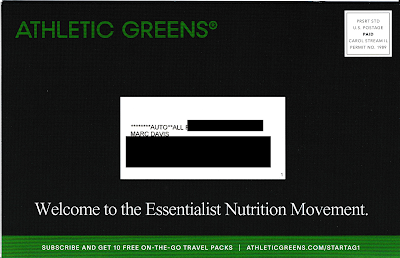 |
| Address panel, with offer URL |
 |
| Inside panel |
- When you include a web address on your solicitation, make sure it works.
- When using snail mail to sell your product, don't assume people will go online to response. Include a phone number in your Call to Action.
- Carefully consider the impact of seasonality when timing your mailing.
11/30/2021
PayPal: Venmo $10 Giveaway Email Lacks Explanation or Focused Targeting
This recent email from PayPal trying to cross-sell Venmo merits Fails for Creative and Targeting.

Enrollment offer email, sent to long-term
Venmo customer
The email offers
me a straight cash bribe (or, as we say in marketing, an incentive) to sign up
for Venmo. The Call to Action is to click on the “Claim Your $10” link that
will bring me to the below landing page.

Landing page
lacks explanation of Venmo product features or customer benefits
The landing page
reinforces the incentive and discloses information about fees -- and allows me
to sign up for Venmo and verify my phone number.
But what is
Venmo? Neither the email nor landing page include a product explanation.
Simply put: If someone hasn’t used Venmo -- which is, after all, the kind of
person the email is targeting -- they would have no idea what it is
or why they should provide their mobile number to get $10. Both the email and
landing page should include benefit statements or at least some brief sales
messages.
Now, in fact, I
know all about Venmo. I’ve been using it for a long time, long enough for
Venmo’s parent PayPal to know that I am an active customer. That is why I give this a Fail for Targeting. There is no value in sending a new customer acquisition
offer to a long-term active customer like myself. Communications like this can
make customers question the strength of a brand.
Speaking of
brand, why doesn’t PayPal put its name behind Venmo -- at least on this
marketing email? For customers who haven’t heard of or used Venmo (like the
ones targeted by the offer), including phrasing such as “backed by PayPal” or
“a PayPal service” would at least lend some credibility to the product.
This isn’t the
first time PayPal has offered me an incentive for something without
explanation. Last year, PayPal sent me an offer for Honey that lacked a product value proposition. Nor is this the first time that PayPal has demeaned its
brand with shoddy marketing communications. These communications can implicitly
send a message to customers that PayPal doesn’t have its act together, which
could lead to decreased trust and decreased use. Is this a company to trust with cryptocurrency purchases?
Sometimes
marketing managers are so obsessed with their products, they forget the basics. That’s why they need to take a step back, review lessons like
the below, and avoid sending Mail That Fails.
Lessons:
- Explain what it is you are selling and why it is beneficial.
- Extend your new customer offer only to potential new customers.
- If selling an affiliate service, consider explaining the relationship with the affiliate.
10/25/2021
DoorDash: No Sleep till Queens ?!?
We live in Queens -- a borough of New York City. It is also it's own county. It is not like any other borough or any other place in the world.
So to suggest that we live in nearby Brooklyn is like someone suggesting San Francisco-based DoorDash is actually in Oakland -- sure, it's nearby, but it's a different world.
I ordered from DoorDash once, although I'm not sure when or why. Maybe it was to take advantage of a credit card offer, or perhaps it was that time last year when my wife and I really, really wanted a Carvel ice cream cake but didn't feel safe taking the subway there in the middle of a pandemic. Regardless, that one order was enough to be added to their email marketing list.
DoorDash knows where I live: firmly in a Queens zip code. So, the only reason to send me an offer email with a Subject line of "Hey, Brooklyn" is to want to get a Fail for Creative. Brooklyn is a nice borough, but to suggest that we live there is insulting to those of us who can walk to the World's Fair Site or the Louis Armstrong Museum -- or can brag they live in the same borough where Peter Parker grew up with his Aunt May.
But, to suggest I live in Brooklyn? Ouch! Not even a month of free pizza could get me to say, "Fuhgeddaboutit." I'm going to just leave this picture here.
Lesson:
If you want to appeal to your customers based on locality, make sure you get their location right.
10/11/2021
Hooters: Timing and Grammar Matter
This birthday email from Hooters merits a Fail for Timing and a Fail for Creative.
The email informs the recipient that he has "10 Free Wings (Birthday)" and that his offer will expire in "1 days."
 |
| Hooters Birthday email arrived well after the birthday |
The recipient's birthday was in late August. He did not receive a communication about his free wings prior to his birthday or on his birthday. The first time he found out he had the opportunity to have free Hooters wings served to him (presumably by a "Hooters Girl") was on September 20 -- one day before the offer expired.
The opening of the email reads:
Just a friendly reminder that your 10 Free Wings (Birthday) is about to expire. Come in and redeem your offer before it expires in 1 days.
This brief paragraph would read better as:
Just a friendly reminder that your 10 Free Wings offer for your birthday is about to expire. Come in and redeem your offer before it expires tomorrow.
One might joke about the sentences being written by a Hooters Girl, but that would be insulting to smart women who take the job. Regardless, it appears to me that the sentence was written by a someone using rudimentary mail merge software. The first sentence identifies the type of free offer in parenthesis. The programming of the second sentence did not take into account that the number of days may be a singular number.
Let's hope the wings are better than the grammar.
Lessons:
- Recognizing a customer's birthday is a useful way to engage a customer, but only if properly executed.
- When using numerical values in your communications, make sure to account for values that are not plural.
8/26/2021
Hard Rock Casino: Guns N' Rose ?!?
8/14/2021
Freshly: Referral Offer Freshens Up
A couple months ago I wrote about a referral offer from Freshly that merited a Fail for Creative. Last week, the company sent me a similar offer and, from a creative and user experience standpoint, it is an improvement.
 |
| Freshly email |
This email is personalized, addressing me by name. Although it positions the referral offer as something I had "earned" (which feels a bit gimmicky), the email does recognize both my purchase history and enthusiasm for the product.
Rather than the previous mailing -- which provided a code to share but without adequate instructions about how to use it -- this email offers a simple link with a Call to Action to "Send a Free Box." That seems easy, and needs no special codes.
The landing page includes a 3-step, easy-to-understand process for the customer to follow to give a friend a free week of Freshly.
 |
| Referral offer landing page |
The input fields are clear. The email message and subject lines include stock language with an opportunity to personalize. That's almost as flexible as switching next week's meal from the Cauliflower Shell Beef Bolognese to the Indian-Spiced Chickpea Curry Bowl.
One element included in the May email that is lacking here, however, is an expiration date. Instead, the email body copy mentions "... and will expire unless you share it soon ...", while the disclosure reads, "Freshly reserves the right to modify, replace, or cancel offer(s) at any time" -- a statement that lacks a sense of immediacy. This is not a Fail for Creative but is an improvement opportunity. Even if this referral offer is intended to be evergreen, I would include a soft expiration date using language such as "... so send a Freebie Box in the next 7 days and give the gift of better meals made easy!"
 |
| Referral offer Thank You page |
- Referral programs are a useful approach to allowing your customers to be your advocates.
- When you want your customers to do something, take all the traction out of the process.
- If your offer does not have a expiration date, at least suggest a timeframe for the customer to take action.
7/25/2021
Sorry, I’m late to ask for your vote
In New York City, our primary election for local offices took place on June 22, with early voting taking place June 12 through June 20.
 |
| Stringer should have been ready and in the mail before Day One |
I received eight oversized postcards from political candidates between June 23 and July 6. A couple of them are shown here.
 |
| This postcard arrived on 6 days after the election, e.g. it is trash |
These are Fails for Timing. I want to say, "Sorry, New York City does not offer late voting."
Lesson:
When producing mail for a political candidate, mail early and mail often.
7/16/2021
Mr. Cooper Renovates His Mail
 |
| Mr. Cooper Invitation to Apply letter |
- Have a clear Call to Action and offer. Communicate it multiple times to encourage action.
- Proofread your communications for language and grammar.
6/09/2021
Charity Mail Deluge
When COVID hit last spring, I thanked God that I was fortunate enough to stay healthy and safe when so many people here in NYC were infected. I wanted to give back but, like many others too frightened to help in person, I chose to donate money. I donated to several charities, including some I had not given to before. That was April, 2020.
Then, starting in October, 2020, this happened:
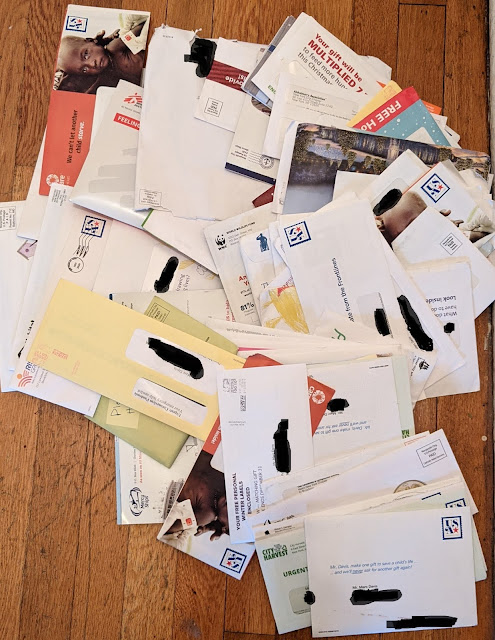 |
| 102 mail fundraising solicitations October - December 2020 |
I received 102 mailed fundraising solicitations from charities to which I had never donated. Most of them were related to feeding people -- in Africa, South America, and Manhattan. Others were for: environmental causes; providing medical care to people in faraway lands; building houses; preventing people from being born with disabilities; helping people born with physical disabilities, orphans, wounded veterans, Native American children, Native American senior citizens, "inner city children" who can't afford a Catholic education, and one that appeared to have something to do with housing recovering drug addicts in hotels.
Many of the classic direct mail fundraising techniques are included: blind envelopes, pictures of children near death; envelope teasers reading "URGENT NEED NOW", "EMERGENCY APPEAL" or simply "PLEASE"; envelopes a layperson might think had been hand-addressed and stamped; tear-jerking letters; promises that my donation would be matched by a mysterious benefactor; business reply envelopes; blessings by nuns; Christmas cards; a decade's supply of return address labels; pens; baby socks; and so on. If you have created or supported direct mail fundraising solicitations, you know these packages.
It appears to me that one or more of the charities that received money from me in spring 2020 chose to make some more money by including my name on a rentable mailing list. I was included on a Hot List of new donors or a timely "COVID Giving List" of sorts.
There is a part of me that feels negative about this experience. I could go into a rant about how the federal government subsidizes charities with lower postage rates, or how many of these organizations are charities in name only because they pour more money into soliciting donations than they do actually supporting their supposed cause. But, hey, that's the nature of the medium.
(Personally, I'm a bit disappointed at myself. I typically research charities, preferring to contribute to those that have low administrative costs and can demonstrate how they are effectively using the money given to them. I didn't fully vet the three that potentially had actualized additional funds from my proactive donation. That's my personal lesson today.)
I looked back at my donation history and narrowed down the list of charities that broke my heart to three. I won't name them here, but I know who they are and I know I will never donate to them again. That type of charity merits a type of Fail for List.
Direct response marketing guru Joan Throckmorton taught me something I wish I had recalled last year: When doing business with a new organization, consider using a fake middle initial. When you see that middle initial show up elsewhere, you know where it came from. So, that's my direct marketing lesson today.
OK, that and including baby socks in your fundraising solicitation is pretty crass.
Lesson:
If you want to see how information about your personal activity is shared and sold, use a fake middle initial. You have 25 of them to work with, so go at it.
6/03/2021
Dunkin': Everything is Direct Marketing, including my name
How do we define "Direct Marketing?" Let's look at the definition from Investopia:
Direct marketing consists of any marketing that relies on direct communication or distribution to individual consumers, rather than through a third party such as mass media. Mail, email, social media, and texting campaigns are among the delivery systems used. It is called direct marketing because it generally eliminates the middleman, such as advertising media.
Put it simply, direct marketing is any direct customer communication. In that context, my communication with Dunkin Donuts Customer Service merits a Fail for Creative.
Last month, I noticed that, for the first time since COVID hit over a year ago, my favorite Dunkin' was open at 5:00 am. The next morning, I tried to advance-order a cup of joe; however, according to the app, the location did not open until 6:00 am. I spoke with the manager, who explained he had been trying for a week with "headquarters" to get the app updated with the correct hours.
I wrote an email to customerservice@dunkinbrands.com:
Hi,
I am a DD loyalty club member: [redacted]My favorite DD is [redacted]I walk my dog at 5:30 am each day. This location is open; however, I cannot place a mobile order because according to your app, it does not open until 6:00 am.I confirmed this morning with the owner/manager that the location is open on weekdays at 5:00 am.My request to you is to update the hours on the app so I can place the order ahead of time and grab the order quickly without having my dog wait too long for me.Thank you,Marc Davis
It was a friendly email with a minor request to improve my customer experience.
Five days later, I received a reply:
Dear Mark,
Thank you for taking the time to contact.
I apologize that your store was closed when you placed your On-the-Go order! We can definitely assist with getting crediting [sic] this transaction for you. Can you please respond with the order number of the transaction that you wish to be credited for? If you have previously sent a screenshot of the order, please respond with the order number from the screenshot, it assists us in locating the transaction faster for you.
We are looking forward to serving you again soon.
Eliezer
Support Center Coordinator
Case #[redacted]
Huh, what?
Dunkin's reply had ignored pretty much everything I wrote. My issue wasn't about an unfilled order, and I wasn't requesting a credit. It was about updating a local store's hours on the app -- and they had ignored that, too. It was as if Eliezer had only scanned my email.
And why did Eliezer misspell my name? I can understand misspelling 'Marc' if I had called Customer Service and provided my name, but they had it in my email. All it would have taken to spell my name correctly was copying & pasting it from the email.
Direct Marketing Association Hall of Fame member Joan Throckmorton once taught me that a person's name is the most important word on a letter. She was right. I hate seeing it misspelled, yet that is what Dunkin' did.
I bit my lip about that last part and responded:
I did not request nor do I see a need for a credit.My request is for your app to be updated so that I can place an order on your app for [redacted] when it opens at 5:00 am on weekdays.Thank you,
Marc
Hello Mark,
Thank you for taking the time to contact us about your experience at the Dunkin' restaurant in [redacted]. We are sorry that you had a bad experience and will alert the franchisee and our field operations team immediately to let them know what happened.
We want every restaurant experience to be a great one and would like to have this experience addressed for you as soon as possible. We take guest satisfaction seriously and hope you’ll give Dunkin' another chance.
Thanks again for taking time out of your day to let us know.
Eliezer
Support Center Coordinator
Case #[redacted]
The reply increased my disappointment: Customer Service was blaming the store even though my unpleasant experience wasn't because of franchisee or from field operations; it was because of the corporate app and Eliezer.
The store hours on the app were updated, but I had a bitter taste in my mouth that wasn't from coffee. I guess Dunkin' can bake the donuts, but cannot adequately read customer emails.
The Starbucks on my dog walking route is also open early. Despite memes like this, Starbucks has never misspelled my name. Just sayin', Dunkin'.
Lessons:
- Every customer interaction is marketing. Every direct customer communication is direct marketing.
- When your customers correspond with you, fully read the communication and reply appropriately.
- Always spell the names of your customers correctly.
5/09/2021
GetRiver.com & Colibri: Less is Less
 |
| Email with Call to Action to buy something now |
- Explanation of the product or service
- Explanation of what the reader is supposed to buy
- Offer expiration date -- specifically, when does the coupon code expire
- At least some information about the cost
- A live Facebook presence when including a link to a Facebook page
- Content on your Twitter page from less than three years ago when including a link to Twitter.
5/02/2021
Freshly: How Do I Share My Code?
This email from Freshly merits a Fail for Creative.
Freshly is a meal subscription service. It offers reasonably healthy, pretty fresh refridgerated meals that can be prepared in the microwave in about three minutes. Personally, during the pandemic lockdown, it helped me have several quick, tasty lunches between Zoom meetings. They've offered a referral program since as long as I've been a customer (at least I think so -- during the lockdown, one business day sometimes faded into the next).
This offer is a bit different. The email recipient, a current customer, is given a "share code" to send a Freshly Freebie to someone who can get a free week of meals. Nice; however, there is no explanation of how to share. The email lacks an explanation of what I or that special someone needs to do to use that share code and enjoy that free food. This lack of explanation puts traction in the customer process of sharing, which reduces the likelihood of customer action.
The offer was sent on April 29 and expires May 6. This means the offer expires only a week after sending. The offer window is appropriately sized for an emailed offer; however, because the expiration date is mentioned only in the disclosure, the attribute of immediacy in the Call to Action is lost. The expiration date should be communicated in body copy, e.g. "Your share code is valid only through May 6, 2021, so be sure to share your Freebie today!"
Lessons:
- Your Call to Action should clearly describe the steps required for the customer to take advantage of your offer.
- Do not bury your offer expiration date in your fine print.
4/15/2021
Norton Lifelock: Renewal Email Reminds Me of Penn & Teller
If
we said it was all scams we could also be in trouble, but 'bulls---,' oddly, is safe. So forgive all the 'bulls--- language', but we're trying to talk about
the truth without spending the rest of our lives in court."
I'll enlarge the fine print to a readable font size:
You are enrolling in an automatically renewing subscription that begins when your purchase is completed online (or otherwise, when your offline payment is received). Please download and install on each device, up to the specified number of devices, to get protection. Price shown is valid for the first term only. After that, your subscription will renew each year at the applicable annual renewal price here. You can cancel your subscription at my.norton.com or by contacting Member Services & Support. For more details, please visit the Refund Policy. Your subscription includes product, service and/or protection updates and new features as available during the subscription term, subject to acceptance of the License and Services Agreement. Features may be added, modified or removed during the subscription term.
* The header of the pricing landing page reads: "Our renewal prices for standalone and add-on subscriptions are listed below. They may change, but we will always send you a notification email prior to billing." In other words, the actual second year price in 12 months could be substantially greater than the price shown today.
